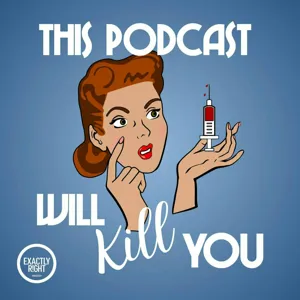Podcast Summary
Hantaviruses transmitted through rodent urine and droppings: Avoid contact with rodent urine and droppings to prevent hantavirus infection, these viruses cause severe respiratory symptoms and can be deadly to humans, they are carried by rodents and not typically transmitted by ticks or mosquitoes.
Hantaviruses are a group of single-stranded RNA viruses that are primarily transmitted to humans through contact with rodent urine and droppings. Unlike many other viruses in the Bunyavirales order, hantaviruses are not typically transmitted by ticks or mosquitoes. Instead, they are carried by rodents, who serve as the natural reservoir for these viruses. The viruses do not cause significant harm to the rodent populations but can be deadly to humans, leading to severe respiratory symptoms and even death. The Sin Nombre virus, which was the focus of the excerpt from "Mice, Men, and Microbes," caused a major outbreak in the southwestern United States in the late 1990s. It's important to avoid contact with rodent urine and droppings to prevent infection. The viruses are named after the order Bunyavirales, which includes a large family of viruses that cause a range of diseases in humans and animals.
Hantaviruses: Two Deadly Diseases with Different Symptoms and Outcomes: Hantaviruses cause two distinct diseases, HPS and hemorrhagic fever, with HPS being more dangerous due to its high mortality rate and non-specific initial symptoms, making early diagnosis challenging.
Hantaviruses, which are primarily transmitted to humans through rodents, cause two distinct diseases: hantavirus pulmonary syndrome (HPS) and hemorrhagic fever with renal syndrome. While hemorrhagic fever may sound more severe due to its name, it's actually HPS that is more dangerous, with a death rate of 38-50%. HPS, primarily caused by the Sin Nombre Virus in the United States, has an incubation period of 1-5 weeks and initially presents with flu-like symptoms without upper respiratory symptoms. However, it's challenging to diagnose during this phase due to its non-specific symptoms. After this phase, the cardiopulmonary phase sets in, leading to shock and pulmonary edema within 24-48 hours, resulting in a high mortality rate. Understanding these differences and similarities can help in early diagnosis and treatment of these diseases.
Hantaviruses cause two distinct forms of disease: HPS and HFRS: Hantaviruses can lead to two severe diseases, HPS with pulmonary edema and heart failure, and HFRS with kidney damage and acute kidney failure. Mortality rates range from 1-70% depending on the specific virus and disease.
Hantaviruses can cause two distinct forms of disease: hantavirus pulmonary syndrome (HPS) and hemorrhagic fever with renal syndrome (HFRS). HPS, which is more common in the Americas, occurs when whole blood leaks from the capillaries into the lungs, leading to pulmonary edema, heart failure, and potentially death. On the other hand, HFRS, which is more common in Europe and Asia, causes damage to the kidneys and can lead to acute kidney failure, shock, and even death. Both diseases have significant mortality rates, with HPS having a 50-70% fatality rate and HFRS having a mortality rate ranging from 1-15%. It's important to note that different hantaviruses can cause varying degrees of severity. For example, Pumala virus in Finland has a low mortality rate, while Hantan virus has a much higher mortality rate. Understanding the differences between these two diseases and their causes is crucial for effective diagnosis and treatment.
Understanding the similarities behind different hantavirus diseases: Hantavirus diseases, including Hemorrhagic Fever with Renal Syndrome and Hemorrhagic Fever with Respiratory Distress Syndrome, share the same underlying mechanism: infection of endothelial cells leading to vasodilation, increased vascular permeability, and potential organ failure.
Despite causing diseases with varying symptoms and severity, all diseases caused by the hantavirus should be referred to by the same name due to their similar underlying mechanisms. Hantavirus infections, such as Hemorrhagic Fever with Renal Syndrome (HFRS) and Hemorrhagic Fever with Respiratory Distress Syndrome (HPS), may present differently, but they both originate from the infection of endothelial cells in blood vessels. This infection leads to vasodilation, increased vascular permeability, and fluid loss, resulting in hypotension and potential organ failure. HFRS primarily affects the kidneys, while HPS primarily affects the lungs, but the underlying cause is the same. It's essential to recognize the connection between these diseases to better understand their mechanisms and improve diagnosis and treatment.
History of Hantavirus Discoveries: Hantaviruses likely infected humans for millennia, but weren't documented until the 1860s, with early evidence dating back to 960 AD. Research into hantavirus transmission began in the 1930s and 40s, but human experimentation during WW2 led to tragic consequences.
Hantaviruses, which have existed for millions of years, have likely infected humans for millennia due to the close relationship between humans and rodents. However, it wasn't until the 1860s that hantavirus outbreaks in humans began to be documented, primarily affecting soldiers during wars due to their living conditions. Early evidence of hantavirus-like diseases can be traced back to 960 AD in China, but it wasn't until the 1930s and 40s that researchers began investigating the transmission of these diseases. Unfortunately, some researchers during World War 2 resorted to human experimentation, leading to the suffering and deaths of thousands of people. Despite these dark chapters in history, modern research continues to uncover new information about hantaviruses and their transmission.
Japan's Unit 731's Inhumane Human Experiments and the Discovery of Hemorrhagic Fever Virus: During WWII, Japan's Unit 731 conducted inhumane experiments on humans, disguising it as studies on nonhuman primates. Post-war, US granted immunity to researchers for their findings. Simultaneously, Soviet Union did the same. Korean War led to discovery of hemorrhagic fever virus in Asian striped field mouse, named after Han Tan River.
During World War II, Japan's military unit, Unit 731, conducted inhumane experiments on human subjects, disguising the research as studies on nonhuman primates. When the US discovered this, instead of prosecuting the researchers, they granted them immunity in exchange for their results. Simultaneously, the Soviet Union was also conducting similar human experiments. The Korean War (1950-1953) brought renewed interest in understanding hemorrhagic fever, a disease causing high casualties among UN forces. Rodents, particularly the Asian striped field mouse (Apodemus agrarius), was identified as the likely carrier of the disease. South Korean scientist Dr. Ho Wang Lee was instrumental in discovering the viral antigen in the lung tissue of the Asian striped field mouse and developing a diagnostic test and vaccine for hemorrhagic fever with renal syndrome. The virus was named after the Han Tan River, which flows near the 38th parallel in Korea. Despite advancements, the trend of naming diseases after geographical markers continues in some cases.
Discovering Hantan Virus during Korean War led to identification of other related viruses: The discovery of the hantan virus during the Korean War led to the identification of other related viruses, such as pumalavirus, Sol virus, and prospect hill virus, through the development of a diagnostic test. This discovery underscores the importance of global collaboration in identifying and understanding infectious diseases.
The discovery of the hantan virus during the Korean War not only led to the identification of other related viruses, but also underscored the tragic history and ongoing division of the Korean peninsula. The hantan virus, which is transmitted through rodent excrement, is believed to be older than other bunyaviruses due to its basal subgroup within the Bunyaviridae family. The diagnostic test developed by Doctor Li allowed for the identification of other viruses, such as pumalavirus, Sol virus, and prospect hill virus, in the American Southwest during a mysterious outbreak in 1993. The deaths of two young and otherwise healthy individuals, Florina Woody and Merrill Behe, raised alarm and led to a widespread search for the cause. Despite initial suspicions of pneumonic plague and influenza, the cause remained elusive until tissue samples tested positive for hantaviruses, providing the first piece of the puzzle in identifying the outbreak. Overall, the discovery of these viruses highlights the importance of global collaboration in identifying and understanding infectious diseases.
The Unknown Origins of Sin Nombre Virus: El Nino years and mild winters can increase rodent populations, leading to hantavirus outbreaks. Sin Nombre virus, initially named 'Navajo flu', was stigmatizing and inaccurate, causing reluctance to seek treatment.
The 1993 outbreak of Sin Nombre virus, a new species of hantavirus, was likely caused by high population levels of deer mice, which were fueled by increased food resources due to an El Nino year and a relatively mild winter. The naming of the virus was contentious, but the name "Sin Nombre" was chosen to reflect its unknown origins. The misconception that the virus was limited to certain ethnicities or income levels, due to its initial name "Navajo flu," led to stigmatization and a lower willingness for people to seek treatment or discuss their disease. Understanding the cycles of rodent populations and the factors that influence them is crucial for predicting and preventing future outbreaks, but long-term monitoring is necessary to gather empirical evidence.
Discovery and Emergence of Hantaviruses: Hantaviruses cause severe respiratory and hemorrhagic syndromes, were only recognized in 1993, and there's no cure or vaccine for most strains. Prevent infection by avoiding contact with rodents and their waste.
Hantaviruses, which cause severe respiratory and hemorrhagic syndromes, have been around for a long time but were only recognized in 1993 during a major outbreak in the US. Since then, other hantaviruses have emerged around the world, some with concerning traits. For instance, the Andes virus in South America may be transmissible person-to-person, which could make controlling its spread difficult. Currently, there is no treatment for hantaviruses, and only one vaccine, Hontavax, is available in China for protection against Hantan and Seoul viruses. The number of hantavirus cases varies greatly by region, with China reporting thousands annually, and the US having very few. Research is ongoing to develop vaccines for other hantaviruses. Despite the challenges, it's crucial to stay informed and take preventative measures, such as avoiding contact with rodents and their urine and droppings, to reduce the risk of infection.
Hantaviruses: Rare in US but Research on DNA Vaccines is Promising: Hantaviruses cause disease in Europe but are rare in US. DNA vaccines offer potential for multivalent hantavirus protection, but infection with one hantavirus doesn't provide immunity to others. Prevent infection by taking precautions during rodent cleanup.
Hantaviruses cause a significant amount of disease in certain parts of Europe but are relatively rare in the US, leading to limited incentive for vaccine development. However, promising research is being conducted on DNA vaccines, which use DNA that codes for viral proteins instead of the proteins themselves, allowing for easier production of multivalent vaccines. It's important to note that infection with one hantavirus does not provide immunity to other hantaviruses. To prevent hantavirus infection, it's recommended to take precautions when cleaning up rodent infestations, such as airing out the area, using disinfectants, and avoiding inhaling particles. While hantaviruses can be dangerous, the risk is relatively low for most people.
Recent Outbreaks of Hantavirus in Argentina and Panama: Two recent outbreaks of hantavirus in Argentina and Panama have resulted in over 130 confirmed cases and 15 deaths. Stay informed and practice good hygiene, but don't let fear consume you.
While there have been recent outbreaks of hantavirus in Panama and Argentina, causing numerous confirmed cases and fatalities, it's important not to let fear of this virus keep you up at night as there are plenty of other things to be anxious about. As of now, there have been at least 131 confirmed cases, including 48 with hantavirus pulmonary syndrome and 11 deaths in Argentina. In Panama, there were 103 confirmed cases, including 48 with hantavirus pulmonary syndrome and 4 deaths. These numbers are subject to change as the outbreaks continue. For more information, sources include "Of Mice Men and Microbes" by Andrea S. Meyer and David M. Harper, "Hantavirus Hunting" by Hoang Lee, and various articles that can be found on thispodcastwillkillyou.com. Remember to wash your hands and stay informed, but don't let hantavirus consume your worry. We'll keep you updated on Twitter and our website.






 In this Episode we talk to guest Jenelle Marie Pierce from The STD Project
In this Episode we talk to guest Jenelle Marie Pierce from The STD Project